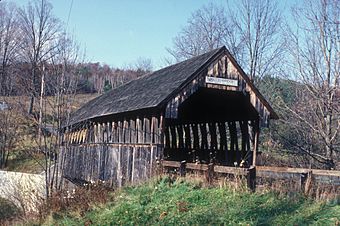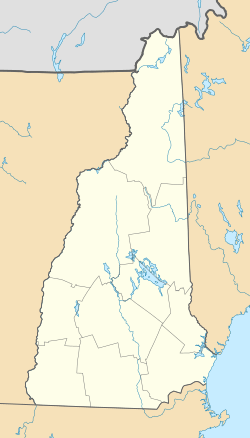Meriden Bridge facts for kids
Quick facts for kids |
|
|
Meriden Bridge
|
|
 |
|
| Location | Colby Mill Rd., Meriden, New Hampshire |
|---|---|
| Area | less than one acre |
| Built | 1880 |
| Built by | James F. Tasker |
| Architectural style | Multiple Kingpost Truss |
| NRHP reference No. | 80000321 |
| Added to NRHP | August 27, 1980 |
The Meriden Bridge is a special old covered bridge in the Meriden area of Plainfield, New Hampshire. It's called a covered bridge because it has walls and a roof, just like a house! This bridge helps Colby Hill Road cross over a small stream called Bloods Brook. It was built around 1880, which makes it one of the oldest covered bridges still standing in New Hampshire. Because it's so old and important, it was added to the National Register of Historic Places in 1980. This list helps protect important historical places.
Contents
What is the Meriden Bridge?
The Meriden Bridge is located north of the village of Meriden. You can find it on Colby Hill Road, just west of Main Street. It's a single-lane bridge, meaning only one car can drive through it at a time.
How Was It Built?
The Meriden Bridge uses a special design called a "multiple Kingpost truss." Imagine a lot of triangles joined together – this makes the bridge super strong! Strong wooden beams, called "chords," are connected to upright posts using tough iron rods. This design helps the bridge hold a lot of weight.
A Look Inside: Bridge Features
The bridge is about 85 feet (26 meters) long and 16 feet (5 meters) wide. The road inside is about 14 feet (4 meters) wide. The lower part of the bridge's sides has wooden boards, reaching about 5 feet (1.5 meters) high. The top parts of the entrances, called portals, also have these boards. The main structure has 22 sections, each about 36 inches (91 cm) wide.
Keeping the Bridge Strong: Its History
The Meriden Bridge was built around 1880 by a man named James Tasker. He was from nearby Cornish and was famous for building covered bridges in the area. Over the years, the bridge has been repaired many times to keep it safe. In 1963, it was completely rebuilt. During this time, new concrete supports were added, and strong steel beams were put in place to help carry the weight of traffic.



